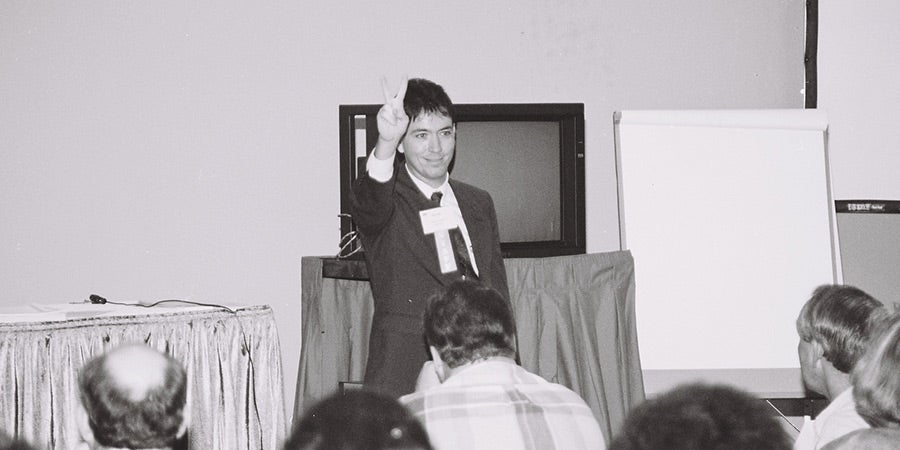Strengthening Good Governance
School board training is not only important for good governance — Texas law requires it. As publicly elected officials whose actions can affect student outcomes, school trustees must be familiar with not only certain laws but also the issues facing schools today and how to function well as a governance leadership team.
The Framework for School Board Development, initially adopted by the State Board of Education in 1996, calls for board members to acquire skills in developing “vision and goals, systems and processes, progress and accountability, advocacy and engagement, and synergy and teamwork.”
That’s quite a syllabus. Fortunately, since TASB’s beginning in 1949, school board training has been a top priority.
“The two strengths of TASB have always been training and networking — raising board members to understand how they can fulfill their role and make their school district stronger, and then networking with other board members at conferences and understanding the challenges that other districts are facing,” said Faye Beaulieu, who served as 2013-14 TASB president while she was a member of the Hurst- Euless-Bedford ISD board. “That’s how you make your own district stronger, so that you’re not just focused internally but you’re focused on the well-being of 5.5 million kids across the state and what those other districts are doing to meet their challenges.”
Training From the Get-Go
Long before board member training was required, TASB recognized the need to clarify complex laws and share best practices with its members. It started the year TASB was founded, in 1949, which happened to coincide with the passage of major legislation that ushered in a new era of education reform in Texas.
The Gilmer-Aikin laws, passed by the 51st Legislature that year, consolidated schools across the state into fewer, more efficient units; created a state funding plan with the establishment of the Foundation School Program; and made major revisions to school services and staffing.
Public school leaders were scratching their heads over all the changes. So, in its earliest days, TASB launched into training mode by providing regular updates on the new laws at regional meetings and with the publication of a newsletter. And at TASB’s first convention, in November 1950, informational sessions focused on how the Gilmer-Aikin laws were impacting schools.
School board members were also eager to learn specifics about the jobs to which they had been elected.
In 1951, a group called the Texas Committee of Ten, consisting of five representatives from the Texas Association of School Administrators and five from TASB, was formed. The initial intent was to study the relationships between board members and superintendents, but the discussion broadened considerably.
The following year, the committee developed the Handbook for Texas School Board Members. Up to that point, school boards had no guidelines or formal written procedures to follow. The handbook was published in May 1952; after reviews and revisions from about 400 people, the first official edition was printed in October 1953.
The committee then started improving workshops, conferences, and association meetings to provide essential materials and answers. Regional workshops that had been held in collaboration with area school board associations since 1955 were gradually expanded to help members understand current education topics, spawning the TASB tradition of Spring Workshops (held every year between February and May across the state).
At long last, a network was in place for TASB to help provide school trustees with the tools and information they desperately needed.
Expanding Into the ‘80s and ‘90s
By the end of the 1970s, TASB training was being offered at workshops across the state and at the annual convention, established in coordination with TASA in 1960. When new legislation required school trustees to obtain more professional development in 1981, TASB staff responded with training on policy, legal, personnel relations, and other subjects.
Then, in 1984, House Bill 72 sent shockwaves through every aspect of public education in the state. Perhaps the most important legislation since the Gilmer-Aikin laws, the bill called for accountability at all levels of education, including the school board. Trustees were required to receive 20 hours of accredited training in 12 standards set up by the SBOE, becoming the only elected officials in the state with such a mandate. Since accredited training was sparse at the time, TASB worked to fill the void — especially after the 1986 TASA | TASB Convention.
“At the Convention [the first held after the mandated training went into effect], approved training sessions were few, seats were scarce, and tempers in the San Antonio heat were hotter than some of the local cuisine,” wrote Bill Nemir, former director of TASB Leadership Team Services (now known as Board Development Services) in the March 1996 Texas Lone Star. “Board members with 15 years’ experience raced newly elected colleagues for seats to hear basic information about the role of the board.”
His account was not only colorful but accurate in describing the intense interest in continuing education among school board members, who not only wanted to comply with the new law but also recognized the value of professional development.
“Most trustees who were determined to leave with 20 hours’ credit and training in the 12 standards managed to complete their task. A few even had cuts, bruises, and the odd sore limb to prove their commitment and fortitude,” wrote Nemir. “In the intervening years, school board member training in Texas has become both more accessible and more appropriate to board member needs.”
Recognizing that changes were needed, the SBOE in 1996 passed a wholly revised version of its rule on training. The Framework for School Board Development (which replaced the 12 standards and would be updated again in 2012 and 2020) requires school trustees to receive an orientation to the Texas Education Code, participate in an annual team-building activity, and obtain additional needs-based continuing education.
The Framework eventually added a focus beyond mere vision. In a recent interview, George McShan, who served as TASB president in 1998-99, said that with the Framework, “we began to really emphasize outcomes. And those outcomes are about student outcomes. What really matters is how well our students are doing.”
The ‘90s ushered in a new era of increased training options for TASB members. Hot topics like strategic planning and site-based decision making were in demand, and TASB ISD was unveiled as a systematic approach to training board members, emphasizing “positive and effective ways to govern and improve local schools.” TASB's premier leadership program, Leadership TASB, began with the Class of 1993, taking experienced board members to a new level of development.
In 1994, TASB hosted its first satellite-delivered board training session. “By uplinking our training to a satellite, we can send the training to anyone with a steerable satellite dish,” reported Texas Lone Star early that year. The first-ever Winter Governance Seminar was introduced in 1998, and a summer iteration of that event followed soon thereafter (now known as Governance Camp).
Because board presidents were tasked with announcing the number of hours of required training accrued by each board member, TASB created a service in 1995 to simplify that process. Through the Continuing Education Credit Reporting Service, trustees could now keep track of hours (whether it be training from TASB or another provider), and the service would issue quarterly reports on board training credit to each district’s superintendent.
The Ever-Challenging 21st Century
TASB moved into high gear as the 21st century demanded new approaches to training. Members had been taking advantage of training via CD-ROM when a new online approach was introduced in 2002. The Online Learning Center was created “to provide greater flexibility and convenience to members.” Board members reported that the OLC “moved learning to a personal, local level” that would help districts save money on travel expenses and accommodate those who lived in remote areas of the state.
The type of training was evolving as well. Specifically defined guidance was developed for new and veteran board members and board officers, and courses were created to address new state-required training in the areas of cybersecurity and the sexual abuse/human trafficking of children.
As educational research had revealed a strong correlation between effective school board governance and student success, TASB introduced XG training in 2017. At the first XG Summit that year, thought leaders and district policymakers shared effective practices in place in Texas school districts and in-depth research on the importance of “eXceptional Governance,” XG for short. Then-Lockhart ISD Board President Steve Johnson said, “What it turned out to be was a total shift in our thinking as a board, coming together as a board to really impact student achievement.” The foundational results of XG have since been applied to customizable in-district consulting.
In March 2020, as COVID-19 shut down the world, TASB necessarily moved into the uncharted territory of virtual training.
A month earlier, Governance Camp unknowingly became the last in-person event for quite some time. In lieu of in-person Spring Workshops, 11 virtual webinars were offered in April and May, with a total attendance of 2,040. In June, the Summer Leadership Institute was TASB’s first attempt at hosting a virtual conference over a period of days. Staff switched gears to provide this virtual training in less than five weeks. More than 1,800 attended the event, complete with several networking sessions and access to on-demand viewing for 30 days.
The TASA | TASB Convention that year, txEDCON2020, was also held online, with over 2,700 participants. More than 160 districts were recognized as having their entire leadership teams in attendance, more than any in the history of Convention.
Clearly, school trustees were not going to put training on hold — even during a pandemic. And neither would TASB.
As it has since 1949, TASB is there to provide appropriate and effective training for school board members — no matter the challenges. And it will continue to develop and refine training to fit specific needs, such as the recently launched Texas Trustee Institute, offering first-year board trustees an immersive learning experience.
After all, training is a primary reason that TASB exists. “Before TASB was founded, school boards across the state had nowhere to go for guidance about the jobs they were elected to do,” said TASB Executive Director Dan Troxell. “In the 75 years since, TASB has provided them not only essential training but also numerous networking opportunities to learn from each other how to deal with the many challenges that school districts face.”
Melissa Locke Roberts
Melissa Locke Roberts is a staff writer for Texas Lone Star.





